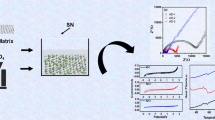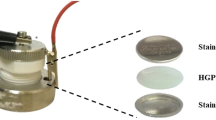Abstract
In the work presented time-stable proton conducting gel electrolytes based on polymethylmethacrylate doped with sulfuric acid solutions in N,N-dimethylformamide were synthesized. The dependences of gels conductivity on the acid concentration and the molecular mass of PMMA at 25–65 °C are studied. The thermal stability of electrolytes was estimated. The FT-IR (ATR) spectroscopy was used for understanding of mechanism of proton transfer.








Similar content being viewed by others
References
Wieczorek W, Zukowska G, Ostrovskii D, Florjanczyk Z (2001) The application of mesoionic compounds into proton-conducting polymer gels. J Phys Chem B 105:9686–9691
Reddy CVS, Zhu Q-Y, Mai L-Q, Chen W (2007) Electrochemical studies on PVC/PVdF blend-based polymer electrolytes. J Solid State Electrochem 11(4):543–548
Sekhon SS (2003) Conductivity behaviour of polymer gel electrolytes: role of polymer. Bull Mater Sci 26(3):321–328
Sekhon SS, Arora N, Chandra S (2003) Proton conducting polymer gel electrolytes with NO2 substituted carboxylic acids. Eur Polym J 39:915–920
Kumar R, Sekhon SS (2009) Conductivity modification of proton conducting polymer gel electrolytes containing a weak acid (ortho-hydroxy benzoic acid) with the addition of PMMA and fumed silica. J Appl Electrochem 39:439–445
Ericson H, Svanberg C, Brodin A, Grillone AM, Panero S, Scrosati B, Jacobsson P (2000) Poly(methyl methacrylate)-based protonic gel electrolytes: a spectroscopic study. Electrochim Acta 45:1409–1414
Senel M, Tulu M, Bozkurt A (2007) Synthesis and proton conductivity of anhydous dendritic electrolytes. Cent Eur J Chem 5(2):546–556
Tsujioka N, Hira N, Aoki S, Tanaka N, Hosoya K (2005) A new preparation method for well-controlled 3D skeletal epoxy resin-based polymer monoliths. Macromolecules 38(24):9901–9903
Ghosh BD, Lott KF, Ritchie JE (2006) Structural characterization of a sol-gel-prepared anhydrous proton-conducting electrolyte. Chem Mater 18:504–509
Sharma JP, Sekhon SS (2006) Conductivity modification of proton conducting polymer gel electrolytes with the addition of fumed silica. Phys Status Solidi A 203(8):2037–2043
Liu C, Zhang J, Shi G, Qu L, Fe C (2003) Proton-conducting gel polyelectrolytes based on Lewis acid. J Appl Polym Sci 90:1267–1272
Jeffrey KR, Zukowska GZ, Stevens JR (2003) Dynamics of the hydrogen and phosphate ions in proton conducting gel/D3PO4 electrolytes: A 2H and 31P nuclear magnetic resonance study. J Chem Phys 119(4):2422–2431
Zukowska GZ, Robertson VJ, Marcinek ML, Jeffrey KR, Stevens JR (2003) Structure of proton-conducting gel electrolytes based on poly(glycidyl methacrylate). J Phys Chem B 107:5797–5805
Celik SU, Aslan A, Bozkurt A (2008) Phosphoric acid-doped poly(1-vinil-1,2,4-triazole) as water-free proton conducting polymer electrolytes. Solid State Ion 179:683–688
Sekhon SS, Arora N, Singh HP (2003) Effect of donor number of solvent on the conductivity behaviour of nonaqueous proton-conducting polymer gel electrolytes. Solid State Ion 160:301–307
Chung SH, Wang Y, Greenbaum SG, Bzducha W, Zukowska G, Wieczorek W (2001) Characterization of perdeuterated H3PO4-doped nonaqueous gel electrolytes using 31P nuclear magnetic resonance spectroscopy. Electrochim Acta 46:1651–1655
Żukowska G, Wieczorek W, Kędzierski M, Florjańczyk Z (2001) Nonaqueous gel electrolytes doped with phosphoric acid esters. Solid State Ion 144:163–173
Grillone AM, Panero S, Retamal BA, Scrosati B (1999) Proton polymeric gel electrolyte membranes based on polymethylmethacrylate. J Electrochem Soc 146:27–31
Chandra S, Sekhon SS, Srivastava R, Arora N (2002) Proton-conducting gel electrolyte. Solid State Ion 154–155:609–619
Wieczorek W, Zukowska G, Borkowska R, Chung SH, Greenbaum S (2001) A basic investigation of anhydrous proton conducting gel electrolytes. Electrochim Acta 46:1427–1438
Lassegues JC, Desbat B, Trinquet O, Cruege F, Poinsignon C (1989) From model solid-state protonic conductors to new polymer electrolytes. Solid State Ion 35:17–25
Vaivars G, Kleperis J, Azens A, Granqvist CG, Lusis A (1997) Proton conducting composite electrolytes based on antimonic acid. Solid State Ion 97:365–368
Shmukler LE, Safonova LP, Thuk NV, Gruzdev MS (2011) Proton-conducting gel electrolytes based on poly(methyl methacrylate) doped with phosphoric acid in N, N-dimethylformamide. Polymer Science, Ser A 53(1):44–51
Sorenson WR, Campbell TW (1961) Preparative methods of polymer chemistry. Interscience publishers, LTD, London
Qiao J, Yoshimoto N, Ishikawa M, Morita M (2003) Proton conductance and spectroscopic characteristics of acid-doped polymer gels based on poly(ethylene oxide)-modified polymethacrylate. Solid State Ion 156(3–4):415–424
Raducha D, Wieczorek W, Florjanczyk Z, Stevens JR (1996) Nonaqueous H3PO4—doped gel electrolytes. J Phys Chem 100(51):20126–20133
Chandra S, Sekhon SS, Arora N (2000) PMMA based protonic polymer gel electrolytes. Ionics 6(1–2):112–118
Wang Y, Ma X, Zhang Q, Tian N (2010) Synthesis and properties of gel polymer electrolyte membranes based on novel comb-like methyl methacrylate copolymers. J Membr Sci 349(1–2):279–286
Sharma JP, Sekhon SS (2006) PMMA-based polymer gel electrolytes containing NH4PF6: role of molecular weight of polymer. Mater Sci Eng, B 129:104–108
Stevens JR, Wieczorek W, Raducha D, Jeffrey KR (1997) Proton conducting gel/H3PO4 electrolytes. Solid State Ion 97:347–358
Segtnan VH, Sasic S, Isaksson T, Ozaki Y (2001) Studies on the structure of water using two-dimensional near-infrared correlation spectroscopy and principal component analysis. Anal Chem 73(13):3153–3161
Fadeeva YA, Demina LI, Gorbunova YG, Shmukler LE, Safonova LP, Tsivadze AY (2003) Orthophosphoric acid-N, N-dimethylformamide system: IR study. Russ J Coord Chem 29(7):515–518
Kuo S-W (2008) Hydrogen-bonding in polymer blends. J Polym Res 15:459–486
Qiao J, Yoshimoto N, Ishikawa M, Morita M (2003) A proton conductor based on a polymeric complex of poly(ethylene oxide)-modified poly(methacrylate) with anhydrous H3PO4. Chem Mater 15(10):2005–2010
Zukowska G, Rogowska M, Wojda A, Zygadlo-Monikowska E, Florjanczyk Z, Wieczorek W (2000) The effect of solvent and proton donor type on the conductivity and physico-chemical properties of poly(vinylidene fluoride)-based proton-conducting gel electrolytes. Solid State Ion 136–137:1205–1209
Kawahara M, Morita J, Rikukawa M, Sanui K, Ogata N (2000) Synthesis and proton conductivity of thermally stable polymer electrolyte: poly(benzimidazole) complexes with strong acid molecules. Electrochim Acta 45(8–9):1395–1398
Tsuruhara K, Rikukawa M, Sanui K, Ogata N, Nagasaki Y, Kato M (2000) Synthesis of proton conducting polymer based on poly(silamine). Electrochim Acta 45(8–9):1391–1394
Sharma JP, Sekhon SS (2007) Nanodispersed polymer gel electrolytes: conductivity modification with the addition of PMMA and fumed silica. Solid State Ion 178:439–445
Acknowledgement
This work was financially supported by Russian Foundation for Basic Researches (grant 11-03-00311-a).
Author information
Authors and Affiliations
Corresponding author
Rights and permissions
About this article
Cite this article
Shmukler, L.E., Van Thuc, N., Fadeeva, Y.A. et al. Proton conducting gel electrolytes based on polymethylmethacrylate doped with sulfuric acid solutions in N,N-dimethylformamide. J Polym Res 19, 9770 (2012). https://doi.org/10.1007/s10965-011-9770-8
Received:
Accepted:
Published:
DOI: https://doi.org/10.1007/s10965-011-9770-8




